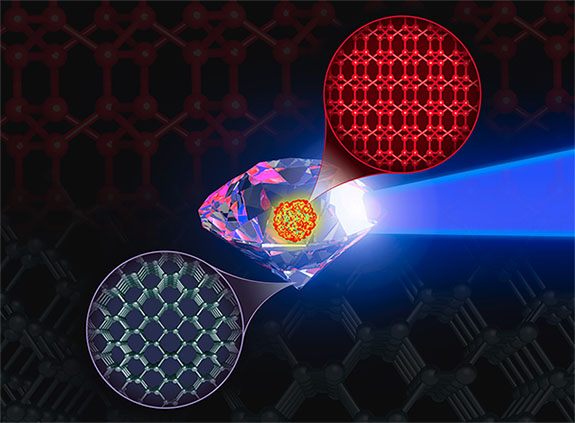March 28th, 2024
Diamond is made of pure carbon and is the hardest material known to man. However, scientists at the Lawrence Livermore National Laboratory (LLNL), Livermore, CA, conducted millions of supercomputer simulations to predict the existence of a carbon-based "super-diamond" that is 30% tougher than its traditional counterpart.

Their next challenge is figuring out how to produce the new super-diamond on Earth.
The scientists call this theoretical new material "BC8" — an eight-atom cubic crystal that exhibits extreme resistance to compression, but only exists under pressures surpassing 10 million atmospheres.
Where do such extreme pressures exist? Researchers point to the center of carbon-rich exoplanets, which have considerable mass and experience gigantic pressures reaching millions of atmospheres in their deep interiors. Unfortunately, nobody on Earth will be visiting an exoplanet anytime soon. Our nearest exoplanet neighbor is 4 light-years away (that's 24 trillion miles).
“The BC8 phase of carbon at ambient conditions would be a new super-hard material that would likely be tougher than diamond,” said Ivan Oleynik, a physics professor at the University of South Florida (USF) and senior author of a paper recently published in The Journal of Physical Chemistry Letters.
One of the reasons a diamond is so hard is that each of its carbon atoms form a perfect tetrahedral shape with four neighbors, creating an extremely stable and strong configuration.
“The BC8 structure maintains this perfect tetrahedral nearest-neighbor shape, but without the cleavage planes found in the diamond structure,” explained study co-author and LLNL scientist Jon Eggert.
Minus the cleavage planes, the super-diamond is predicted to offer a 30% greater resistance to compression.
Harnessing the power of Frontier, the world’s fastest supercomputer, the team performed multi-million atomic molecular-dynamics simulations and learned that BC8 can only be synthesized within a very narrow range of pressures and temperatures.
The team at LLNL dreams of one day growing BC8 super-diamonds in the laboratory. If they are eventually successful, the new super-diamond could lead to advancements in manufacturing, space exploration and technology. Whether the new material will have applications for the jewelry industry has yet to be determined.
Credit: Image by Mark Meamber/LLNL.

Their next challenge is figuring out how to produce the new super-diamond on Earth.
The scientists call this theoretical new material "BC8" — an eight-atom cubic crystal that exhibits extreme resistance to compression, but only exists under pressures surpassing 10 million atmospheres.
Where do such extreme pressures exist? Researchers point to the center of carbon-rich exoplanets, which have considerable mass and experience gigantic pressures reaching millions of atmospheres in their deep interiors. Unfortunately, nobody on Earth will be visiting an exoplanet anytime soon. Our nearest exoplanet neighbor is 4 light-years away (that's 24 trillion miles).
“The BC8 phase of carbon at ambient conditions would be a new super-hard material that would likely be tougher than diamond,” said Ivan Oleynik, a physics professor at the University of South Florida (USF) and senior author of a paper recently published in The Journal of Physical Chemistry Letters.
One of the reasons a diamond is so hard is that each of its carbon atoms form a perfect tetrahedral shape with four neighbors, creating an extremely stable and strong configuration.
“The BC8 structure maintains this perfect tetrahedral nearest-neighbor shape, but without the cleavage planes found in the diamond structure,” explained study co-author and LLNL scientist Jon Eggert.
Minus the cleavage planes, the super-diamond is predicted to offer a 30% greater resistance to compression.
Harnessing the power of Frontier, the world’s fastest supercomputer, the team performed multi-million atomic molecular-dynamics simulations and learned that BC8 can only be synthesized within a very narrow range of pressures and temperatures.
The team at LLNL dreams of one day growing BC8 super-diamonds in the laboratory. If they are eventually successful, the new super-diamond could lead to advancements in manufacturing, space exploration and technology. Whether the new material will have applications for the jewelry industry has yet to be determined.
Credit: Image by Mark Meamber/LLNL.


